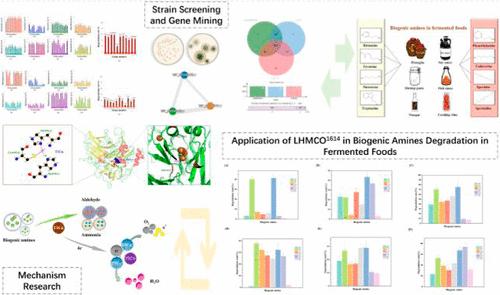当前位置:
X-MOL 学术
›
J. Agric. Food Chem.
›
论文详情
Our official English website, www.x-mol.net, welcomes your
feedback! (Note: you will need to create a separate account there.)
Multicopper Oxidase from Lactobacillus hilgardii: Mechanism of Degradation of Tyramine and Phenylethylamine in Fermented Food
Journal of Agricultural and Food Chemistry ( IF 5.7 ) Pub Date : 2024-07-24 , DOI: 10.1021/acs.jafc.4c02319 Qilin Yang 1, 2 , Yitao Bai 1, 2 , Shuangping Liu 1, 2, 3, 4 , Xiao Han 1, 2, 3, 4 , Tiantian Liu 1, 2, 3, 4 , Dongna Ma 1, 2, 3, 4 , Jian Mao 1, 2, 3, 4
Journal of Agricultural and Food Chemistry ( IF 5.7 ) Pub Date : 2024-07-24 , DOI: 10.1021/acs.jafc.4c02319 Qilin Yang 1, 2 , Yitao Bai 1, 2 , Shuangping Liu 1, 2, 3, 4 , Xiao Han 1, 2, 3, 4 , Tiantian Liu 1, 2, 3, 4 , Dongna Ma 1, 2, 3, 4 , Jian Mao 1, 2, 3, 4
Affiliation

|
Elevated levels of biogenic amines (BAs) in fermented food can have negative effects on both the flavor and health. Mining enzymes that degrade BAs is an effective strategy for controlling their content. The study screened a strain of Lactobacillus hilgardii 1614 from fermented food system that can degrade BAs. The multiple copper oxidase genes LHMCO1614 were successfully mined after the whole genome protein sequences of homologous strains were clustered and followed by homology modeling. The enzyme molecules can interact with BAs to stabilize composite structures for catalytic degradation, as shown by molecular docking results. Ingeniously, the kinetic data showed that purified LHMCO1614 was less sensitive to the substrate inhibition of tyramine and phenylethylamine. The degradation rates of tyramine and phenylethylamine in huangjiu (18% vol) after adding LHMCO1614 were 41.35 and 40.21%, respectively. Furthermore, LHMCO1614 demonstrated universality in degrading tyramine and phenylethylamine present in other fermented foods as well. HS-SPME-GC-MS analysis revealed that, except for aldehydes, the addition of enzyme treatment did not significantly alter the levels of major flavor compounds in enzymatically treated fermented foods (p > 0.05). This study presents an enzymatic approach for regulating tyramine and phenylethylamine levels in fermented foods with potential applications both targeted and universal.
中文翻译:

希尔加氏乳杆菌多铜氧化酶:发酵食品中酪胺和苯乙胺的降解机制
发酵食品中生物胺 (BA) 含量升高会对风味和健康产生负面影响。挖掘降解 BA 的酶是控制其含量的有效策略。该研究从发酵食品系统中筛选出一株能够降解BAs的希尔加迪乳杆菌1614。通过对同源菌株全基因组蛋白序列进行聚类并进行同源建模,成功挖掘出多个铜氧化酶基因LHMCO 1614 。分子对接结果表明,酶分子可以与 BA 相互作用,稳定复合结构以进行催化降解。巧妙的是,动力学数据表明纯化的 LHMCO 1614对酪胺和苯乙胺的底物抑制不太敏感。添加LHMCO 1614后黄酒(18%vol)中酪胺和苯乙胺的降解率分别为41.35和40.21%。此外,LHMCO 1614在降解其他发酵食品中存在的酪胺和苯乙胺方面也表现出普遍性。 HS-SPME-GC-MS 分析表明,除醛外,酶处理的添加并没有显着改变酶处理发酵食品中主要风味化合物的水平( p > 0.05)。这项研究提出了一种调节发酵食品中酪胺和苯乙胺水平的酶促方法,具有针对性和普遍性的潜在应用。
更新日期:2024-07-24
中文翻译:

希尔加氏乳杆菌多铜氧化酶:发酵食品中酪胺和苯乙胺的降解机制
发酵食品中生物胺 (BA) 含量升高会对风味和健康产生负面影响。挖掘降解 BA 的酶是控制其含量的有效策略。该研究从发酵食品系统中筛选出一株能够降解BAs的希尔加迪乳杆菌1614。通过对同源菌株全基因组蛋白序列进行聚类并进行同源建模,成功挖掘出多个铜氧化酶基因LHMCO 1614 。分子对接结果表明,酶分子可以与 BA 相互作用,稳定复合结构以进行催化降解。巧妙的是,动力学数据表明纯化的 LHMCO 1614对酪胺和苯乙胺的底物抑制不太敏感。添加LHMCO 1614后黄酒(18%vol)中酪胺和苯乙胺的降解率分别为41.35和40.21%。此外,LHMCO 1614在降解其他发酵食品中存在的酪胺和苯乙胺方面也表现出普遍性。 HS-SPME-GC-MS 分析表明,除醛外,酶处理的添加并没有显着改变酶处理发酵食品中主要风味化合物的水平( p > 0.05)。这项研究提出了一种调节发酵食品中酪胺和苯乙胺水平的酶促方法,具有针对性和普遍性的潜在应用。











































 京公网安备 11010802027423号
京公网安备 11010802027423号